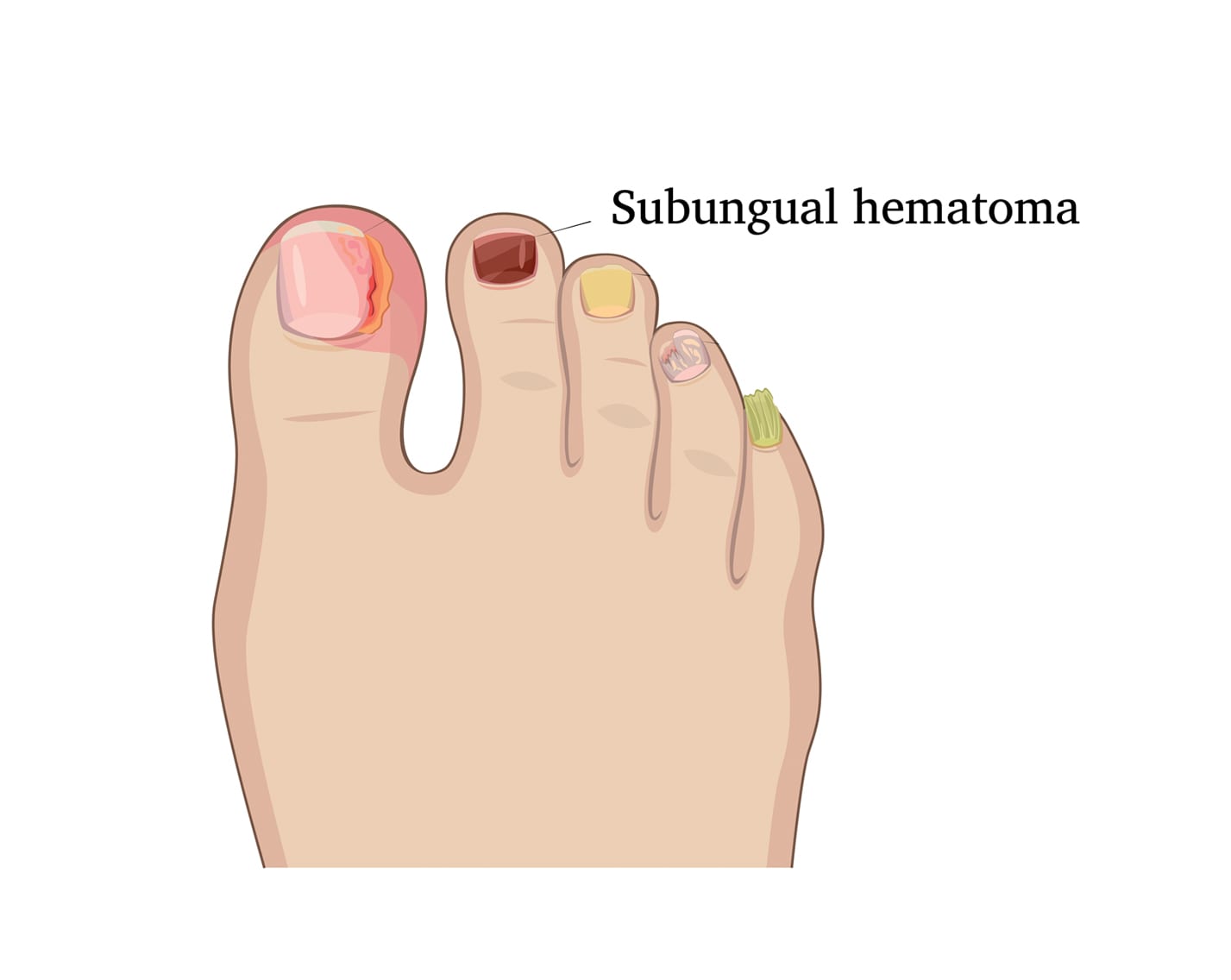A subungual Hematoma, also called “runner’s toe,” is a buildup of blood in the nail bed that gives the appearance of a purple toenail. The injury is caused by damage to the blood vessels in the toe. It’s common among runners and other athletes. Runners’ toe treatment is usually home-based, but athletes should see a doctor if they see signs of infection or if the condition doesn’t improve rapidly.
Subungual Hematoma Causes, Symptoms & Treatment Options
A subungual Hematoma, also called “runner’s toe,” is a buildup of blood in the nail bed that gives the appearance of a purple toenail. The injury is caused by damage to the blood vessels in the toe. It’s common among runners and other athletes
Overview
Overview

What causes Subungual Hematoma?
Runner’s toe is caused by broken blood vessels in the nail bed. This nail bed injury often results in a subungual hematoma, where blood under the toenail builds up and causes discoloration and pain. Often, this happens as a result of an acute toenail trauma, like stubbing your toe or dropping a heavy object on it commonly referred to as a crushed nail. This injury can also be caused by repetitive stress to the toe. Runners and dancers are at risk because of the down-striking forces involved in their sports. Shoes that are too tight can put pressure on the toes, contributing to this condition and leading to throbbing toe pain.
Subungual hematoma/runner’s toe is most common in these sports:
- Running
- Dancing
- Tennis
- Rock Climbing
Symptoms
The primary symptom of runner’s toe is pain in toenail area. The nail also becomes discolored due to blood pooling up in the nail bed, until the nail either falls off or grows out. Common symptoms also include:
- Reddish-purple color under the nail
- Nail gradually turning dark brown or black
- Pain that resolves in two to three days
When to see a doctor
If your symptoms aren’t the result of an acute injury, the bleeding under your toe doesn’t stop, or you have signs of an infection like a fever or pus, you should see a doctor. Usually, your doctor can make a diagnosis based on your medical history and a physical examination. Sometimes, x-rays are taken if there is a concern you have fractured your toe or have some other condition causing your symptoms, especially if a subungual hematoma or crushed nail is suspected.
Non-operative treatment
Treatment for subungual hematoma/runner’s toe is usually minimal and home-based. Conservative runner’s toe treatments include:
- Rest from activities that could re-injure your toe.
- Applying ice or soaking your toe in cool water for 20 minutes, two or three times daily
- Elevating the leg
- Nonsteroidal anti-inflammatory drugs (NSAIDs), such as ibuprofen and naproxen, to help relieve pain and inflammation
If the pressure on your nail is too intense, your doctor may recommend draining the blood by making small holes in your nail.
You can also try these exercises at home:
Surgical Treatment
Surgery is not needed to treat runner’s toe.
Recovery
It may take several weeks for a new nail to fully grow back, but pain from the toenail trauma should resolve fairly quickly. To ensure a full recovery, once throbbing toe pain goes away, athletes should ease back into play (e.g., with shorter runs). To prevent re-injury, make sure you keep the toenails short and wear properly fitting shoes to avoid another nail bed injury or subungual hematoma.
Treatment Timeline
Day 1–3: Apply ice, elevate the foot, and avoid pressure. OTC pain relievers may help with throbbing toe pain.
Day 4–7: If pain persists or discoloration worsens, seek medical evaluation. Drainage may be required if blood under toenail is significant.
Week 2–3: Pain should subside. Continue to avoid intense physical activity.
Week 4–6: Nail regrowth begins. Resume light activities. Monitor for signs of infection.
Week 6–12: Full nail regrowth may take several weeks to months, depending on the extent of the crushed nail or toenail trauma.
GET BACK TO WHAT YOU LOVE. FASTER
Frequently Asked Questions
Can a crushed nail heal on its own?
Yes, minor cases of a crushed nail often heal without treatment. However, if there's severe pain, throbbing toe pain, or signs of infection, medical attention is recommended.
How long does it take for a nail bed injury to heal?
Pain typically resolves within a few days to a week. Complete nail regrowth after a nail bed injury may take 6–12 weeks, depending on severity.
What should I do if I have throbbing toe pain after toenail trauma?
Elevate the foot, apply ice, and use pain relievers. If throbbing toe pain continues or worsens, especially with blood under the toenail, consult a doctor.
How can I prevent toenail trauma while running or playing sports?
Keep toenails short, wear well-fitted shoes, and avoid repetitive impact on your toes to minimize the risk of subungual hematoma or toenail trauma.

